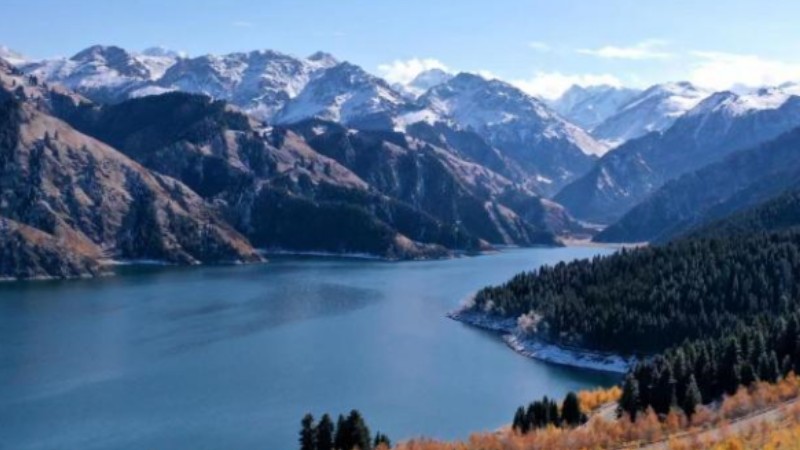Xi Focus-Closeup: Environment first for the Yangtze River
BEIJING, Oct. 14 (Xinhua) -- During an inspection of east China's Jiangxi Province earlier this week, President Xi Jinping walked into a production control center and a lab of Sinopec Jiujiang Company in Jiujiang City.
There, Xi, also general secretary of the Communist Party of China Central Committee and chairman of the Central Military Commission, learned about the enterprise's efforts to build green and intelligent factories as well as promote energy conservation, and reduce pollution and carbon emissions.
The company, situated near the Yangtze River, is the largest petrochemical firm in the province. It has invested over 2 billion yuan (about 278.6 million U.S. dollars) since 2016 in nearly 30 projects to mitigate pollution and propel green transformation.
Reducing pollution from chemical companies along the Yangtze River is key to advancing the environmental management of the river, Xi said.
He called for continuous efforts on pollution control at the source and the whole-process reduction of pollution and carbon emission, as well as promotion of digital and intelligent transformation and green transition to build the company into a world's leading green intelligent refining and chemical enterprise.
While chemical firms like Sinopec Jiujiang Company have been economic drivers for many cities along the river, they also posed significant environmental challenges.
In January 2016, Xi inspected Chongqing Municipality at the upper reaches of the Yangtze River, which was plagued by industrial waste, sand mining and vessel emissions. Water quality deteriorated, while lakes and wetlands were drying up.
The mother river "fell ill, very ill," he said, expressing deep concern.
Xi was determined to cure the river. "To restore its ecological environment will be an overwhelming task at present and for a rather long period to come," he said, urging all-out efforts to protect the Yangtze River.
Later that year in September, China rolled out a development plan for the Yangtze River Economic Belt aimed at removing the constraints on its potential including grim environmental conditions, clogged river traffic, regional imbalances and outdated industries. Environmental protection and restoration was made a top priority.
The Yangtze River Economic Belt covers nine provinces and two municipalities including Jiangxi, Hubei, Jiangsu and Chongqing, and accounts for more than 40 percent of the country's population and economic aggregate.
Central China's Hubei, the province with the longest Yangtze River passage, took the initiative to ensure that there would be no chemical firms within 1 kilometer from the river.
Hubei Xingfa Chemicals Group, a major manufacturer of fine phosphoric chemicals, had by 2018 shut down production facilities worth 1.2 billion yuan near the shore, and worked on ecological restoration on over 800 mu (about 53 hectares) of land.
That's why, during Xi's visit to the company in April 2018, workers were dismantling factory buildings as ginkgo and sweet osmanthus trees began to bloom in the company's vacated space along the river.
"The Yangtze River is China's mother river, and we must protect it, while enterprises are the major force in protecting and building the ecological environment of the river," Xi said during the visit.
To this end, regions along the economic belt have been seeking greener paths of development.
Hubei has seen the total revenue of its chemical industry reclaim the top spot in central China after transformation and upgrading. Jiangsu's Changzhou City, having removed all low-end chemical firms along the shore to make space for greening and emerging industries, saw its new energy sector boost industrial output growth by 9 percentage points in the first seven months of 2023.
Chemical firms greened the shoreline they vacated, and waters are now lucid. Official data showed that the proportion of surface water of fairly good quality -- at or above Grade III in the country's five-tier water quality system -- within the Yangtze River Economic Belt rose to 96.8 percent in the first half of 2023.
The population of the Yangtze finless porpoises, a barometer of water quality in the Yangtze River basin, had increased to 1,249 in 2022, up 23.42 percent from five years ago.
Remarkable changes have been made in the region in the past eight years since the implementation of the Yangtze River Economic Belt development strategy, and it has turned into a consensus to promote well-coordinated environmental conservation and avoid excessive development, Xi said at a symposium held during the Jiangxi inspection.
"The Yangtze River is the link of the Yangtze River Economic Belt. No matter how the Yangtze River Economic Belt will develop in the future and what stage of development it will reach, it is impossible to do without the nurturing of the Yangtze River," Xi said on Tuesday while visiting the Yangtze River National Culture Park in Jiujiang.
"The Yangtze River should be protected with a vision of the lasting and sustainable development of the Chinese nation and of the community of life with harmonious coexistence between humanity and nature," he added.
Photos
Related Stories
Copyright © 2023 People's Daily Online. All Rights Reserved.









